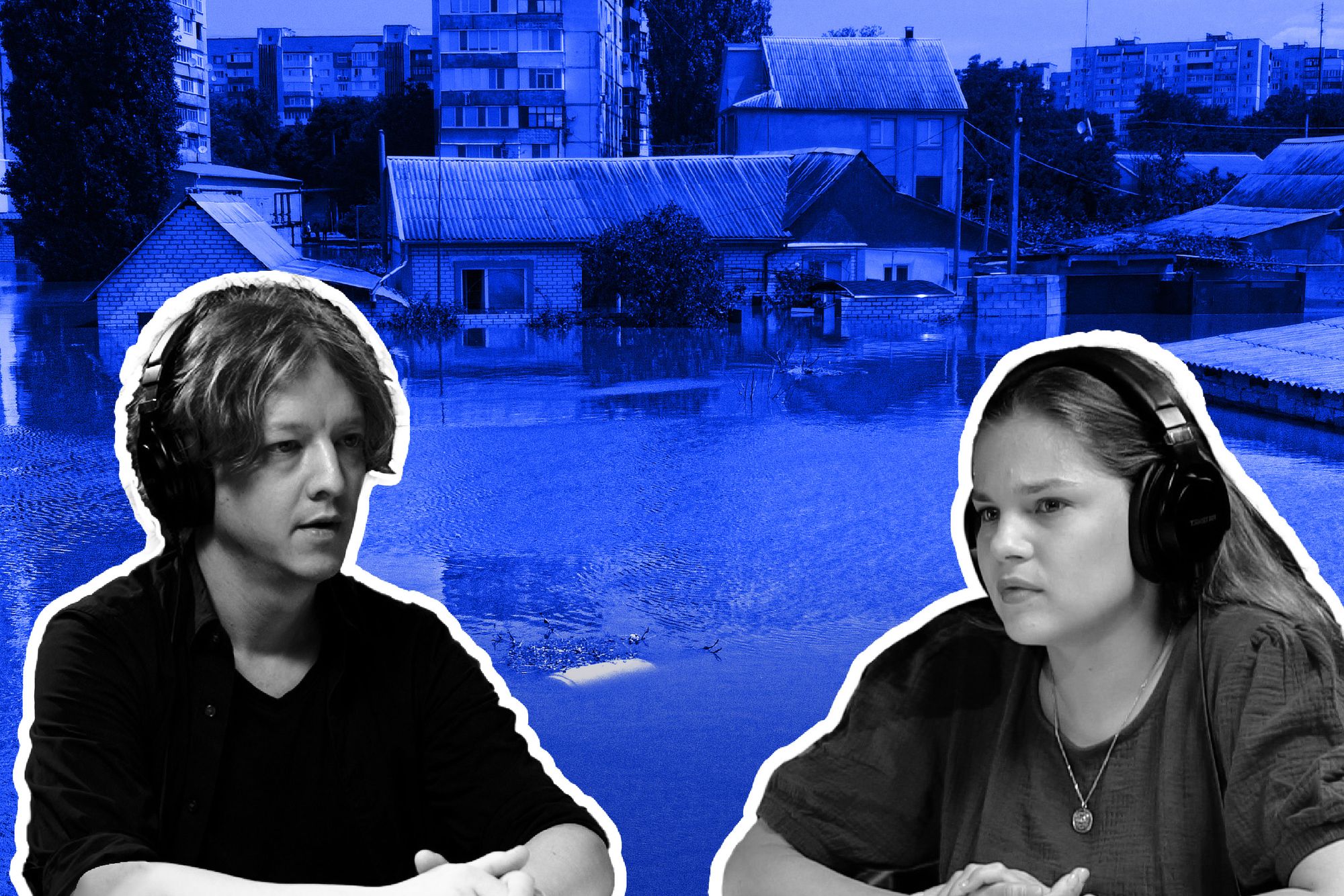Kakhovka dam destruction disrupts water, power supply but offers sustainable reset

In the early morning of June 6, Russia blew up a major dam in the occupied part of southern Ukraine, causing a humanitarian and ecological crisis.
The Kakhovka dam, located on the Dnipro River, is a major waterway running through southeastern Ukraine and the last of a series of six Soviet-era dams.
The Kakhovka Hydroelectric Power Plant played an important role in Ukraine’s power grid and water supply, and its destruction is a major blow to the country’s food, water, and energy system.
But it also offers an opportunity for betterment.
Power supply
The Kakhovka dam, towering 30 meters and stretching 3.2 kilometers, is not a stand-alone structure. It is a cascade of hydro-technical structures comprising a water spill dam, a hydropower generator complex, and additional structures that help generate water supply as well as shipping and fishing logs, according to Serhiy Porovskyy, head of the Energy Efficiency Committee of the Professional Association of Environmentalists of the World (PAEW).
The complex was completed in 1956 as part of the Soviet Union’s rapid development of hydroelectric power, which began in the 1920s.
However, its location “is an anomaly,” according to Vlad Mykhnenko, an Oxford University professor studying the urban development of post-Soviet countries.
Hydropower is usually found in mountainous areas with fast-flowing rivers and steep terrains, but Ukraine is dominated by plains with slow-flowing waters. Building the Kakhovka hydropower plant required flooding an enormous amount of territory, which is why there is nothing of the same scale in the European plains of the Rhine and Danube rivers.
The construction of the plant in this location had four purposes, according to Porovskyy, which have also come to define its modern use: power generation, water supply, securing the shipping route, and water levels necessary for shipping.
Since Ukraine gained independence in 1991, the dam has been operated by the state-owned enterprise Ukrhydroenergo, producing 10.4% of the company's total energy and 0.7% of Ukraine's overall energy balance, according to Ukrhydroenergo's 2021 data.
In Ukraine's energy mix before the war, hydroelectric power comprised about 9-10% of the total energy, while atomic energy accounted for roughly 50%, heat energy around 40%, and renewables only 1%.
Although hydroelectric power wasn't a major energy source for Ukraine, the Nova Kakhovka dam played a role in diversifying the country's power generation. It was particularly important for Kherson's regional strategy to increase the use of renewable energy sources.
“Predictability of renewable energy generation is an issue – you cannot control how much sun or wind you will get that day,” said Porovskyy, which is why the Kakhovka plant was used to cover the daily consumption and compensate for the instability of the output from solar panels and wind turbines.
However, the significance of the complex extended beyond energy production. Its primary purpose was water supply.

Water supply
The Kakhovka hydropower complex was Ukraine's second-largest reservoir, providing four oblasts, Kherson, Mykolaiv, Zaporizhzhia, and Dnipropetrovsk, with water, which was distributed through a network of canals.
Amongst these were the Dnipro-Kryvyi Rih Canal, which supplied Dnipropetrovsk Oblast, and the Verkhnio-Hachynsky Canal, which supplied the northern Zaporizhzhia Oblast.
The Northern Crimean Canal was particularly important as a water source for the western Kherson Oblast and the Crimean Peninsula, which is currently entirely occupied by Russia. Another significant waterway was the South Ukrainian (Kakhovsky) Canal, which supplied water to Kherson Oblast before flowing into Zaporizhzhia Oblast.
The irrigation system facilitated by the Kakhovka complex transformed an area historically plagued by droughts, dust storms, and crop failures every 3-4 years into the most productive region in Ukraine.
Before the dam breach, there were 330,000 hectares of irrigated land growing 80% of all vegetables in Ukraine and a significant percentage of fruits and grapes, said Vadym Dudka, a local agronomist and CEO of Agroanaliz Ltd, an international agro-consulting company.
Over the years, the area has attracted major food producers.
Amongst them is the American–Ukrainian Freedom Farm, the country’s largest producer of corn on irrigated land, one of the largest global producers of tomato paste, AgroFusion (otherwise known as InAgro), one of the country’s biggest food processing companies Chumak and PepsiCo’s potato factories and plantations. These enterprises relied on water from the Kakhovka hydropower plant to irrigate crops.

According to Dudka, 85-90% of the irrigated fields in the region were predominantly dedicated to growing corn and soybeans, Ukraine’s major exports.
In 2021-2022, Ukraine was the sixth-largest producer and the fourth-largest exporter of corn globally and the world’s ninth-largest producer and seventh-largest exporter of soya – with a production increase of 80% from the previous year.
Both crops cannot grow on Kherson Oblast’s light sandy soils without irrigation. Soya can also be grown in central Ukraine, but in Kherson Oblast, soya is high in protein and yields twice as much.
According to a recent article by Ukrainian agribusiness expert Andriy Yarmak, most agricultural products in the area depend on this system, particularly fruits, and vegetables.
The Kakhovka reservoir had a massive volume of water, including groundwater hidden from the eye but crucial for plant growth. The groundwater flow depends on the reservoir's water level, and reducing it drastically causes the groundwater to follow suit. This, in turn, causes plants to dry up as their root systems rely on the saturated soil for nourishment.
Considering Kherson Oblast's scorching heat and average annual precipitation of 400 mm, mostly occurring outside the growing season, long-term crop production in the region becomes unfeasible without reliable irrigation.
Sustainable reset
Once the war is over and territory is restored, Ukraine’s government said it plans to dismantle and construct a new plant on the same spot, which could cost up to one billion dollars and take at least five years to complete, according to the Ministry of Economy.
But it doesn’t necessarily have to.
The Kakhovka dam’s destruction provides an opportunity to reconsider the country's approach to energy, food, and water security, much of which still relies on infrastructure built during the Soviet era.
Scientists that have been tracing the long-term environmental effects associated with Soviet-era hydropower plants have discussed the need to gradually, over decades, lower the Kakhovka reservoir (and other reservoirs) altogether.
“The reservoir was built in the 1950s when nobody thought about environmental consequences,” said Ukrainian environmentalist Olexiy Burkovskyy.
Not only did the construction of the hydropower plant destroy 257,000 hectares of reeds, forests, and lakes and flood a hundred villages, displacing 37,000 people, but it also passed on environmental concerns to future generations.
One issue is the deteriorating condition of the Dnipro River in Kherson Oblast. According to Hryhoriy Romanenko, a member of Ukraine's National Environmental Council, the Dnipro River is not delivering enough water to the Black Sea due to infiltration processes. This is causing water areas in Kherson Oblast to become swamped and self-poisoned, which has decreased natural biological productivity in the Dnipro River in Kherson Oblast by 32 times over the past 30 years.
Another issue is the gradual soil deterioration due to higher salt concentrations in the tributaries of the Dnipro River used for irrigation in the Steppe zone, according to Burkovskyy.
Furthermore, experts of the National Ecological Center of Ukraine (NECU) generally question the efficiency of the Kakhovka plant because it suffers 25-30% of energy loss used to operate the hydro-accumulator, wrote Oleksiy Angurets, ecologist and head of the NGO Clean Air for Ukraine.
Efficiency is why Porovskyy also doesn’t see a need to build another complex of similar scale – the power output of the old plant was not optimal compared to its full hydropower potential.
The most important thing will be that the plant “establishes necessary water levels for irrigation and shipping,” he said, “maybe the solution is to build a few smaller hydropower plants instead.”
The fate of the Kakhovka plant and future projects depends on how the country will approach the question.
The solution will require considering the impact on economic development, such as power generation, water supply, agriculture, fisheries, and shipping, but also human development in the region.
“The key will be to make smart decisions – we need to assess the environmental concerns and the benefits for local people,” Porovskyy said.

















